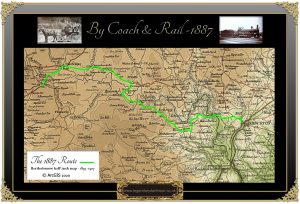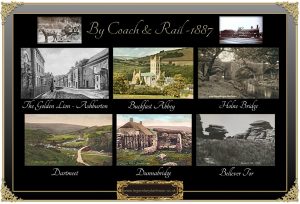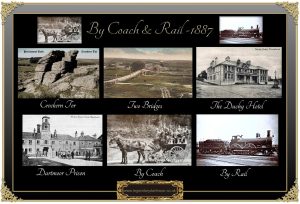
Since the popularity of Dartmoor excursions began in the mid 1800s it was not always possible to get to the starting points from which the ‘tour operators’ ran. Even with the advent of the early Dartmoor railroads it still made experiencing the Moor difficult. So in the late 1888s both the railway companies and the ‘tour operators’ came up with the idea of linking the two modes of transport thus providing a relatively easy way of getting to enjoy the Moor in all its glory. The trains would convey the visitors to a town where they could then embark on a horse carriage tour which took them along the most scenic routes. Having ‘done’ a day on Dartmoor and benefitted from the healthy bracing air they could then simply catch a return journey home. Here is an account of the first joint inaugural excursion taken in the June of 1887.
“The inaugural trip of a series of circular excursions across Dartmoor – oft talked of and long wished for – came off under auspicious circumstances on Wednesday, the 1st of June. Last year a slight effort was made by the railway authorities and others, to open up a route to the moor, but as the idea only reached a practical solution towards the close of the season, (and only a limited area being then proposed to be visited) the project naturally did not come very prominently before the public. Very different, however, are the auspices under which the excursions have been organised this year. There are various routes arranged, but the one from Totnes to Ashburton by rail, and thence to Princetown by coach, returning to destination by rail (Known as No.3 Tour) is the one which more especially concerns the public in this locality, and on that account it is proposed to give a short account sketch for the benefit of whom may be concerned.
Favoured by fine weather, and essential to the enjoyment of a day on the moors, a somewhat representative gathering assembled at Totnes Station. The customary greetings having been observed, Mr. C. E. Compton, the able and courteous divisional superintendent of the G.W.R., Plymouth, was espied, and cordially welcomed by the chairman of the Buckfast Railway Company (Mr. Jeffrey Michelmore), who, in referring to the pleasure in store, humorously observed “the day would add ten years to his life.” Comfortable seats having been taken in the train timed to leave Totnes at 10-20 a.m. a pleasurable run of about half and hour’s duration was experienced along the Buckfastleigh branch railway – which skirts the Dart the greater part of the distance, – unfolding in its course, the verdant meadows and picturesque woods of Dartington and Staverton, the far-famed orchards of the latter, now one mass of blossom, presenting a charming spectacle. Stretching out on a grassy slope on the margin of the river, not far from Buckfastleigh station, stands portions of the fine old Abbey of Buckfast, a Cistercian house, founded in 1137, by Ethelwald de Pomeroy, on the site of an ancient Benedictine house. In 1538, however, it shared the common doom, but a few years since, on a section of the Romish persuasion being expelled from France, they settled in England and purchasing what remained of the Abbey, now propose to raise it to its original proportions. After a few minutes run beside the side of the Yeo, a tributary of the Dart the terminus of the branch line is reached.
Here (Ashburton railway station) the party were met by Host Sawdye, of the Golden Lion Hotel, who intimated that all arrangements are complete for the Moorland Drive. Having repaired to this celebrated hostelry and partaken of refreshments the company proceeded to explore the well-kept gardens and tastefully laid out grounds at the rear – the orange coloured oriental poppies and other perennials lending quite a brilliance to the scene. Here was also brought to mind the doings of the “good old days,” for strangely enough high up on the oak doors of the ball room had just been discovered in clear letters the words “Jubilee Room,” which were evidently painted some fifty years ago, and singularly enough had never been noticed until this year, the “Jubilee,” of Her Most Gracious Majesty. It is conjectured that the room was specially erected for a ball on the Jubilee of King George III. The coach now being announced all are anxious to secure good seats, and a move is made for the purpose. A commodious and well-appointed conveyance with four-in-hand is awaiting, and seventeen are found to comprise the opening trip.
Holne Bridge with its ivy-clad buttresses and parapets, about two miles distant form Ashburton, now meets our gaze, and halt thereon, permits all to admire the waters of the Dart surging, rushing and tumbling down over the granite boulders, which ever and anon shoot up and obstruct its path. Hard by is the lower entrance to the celebrated Buckland Drives, but our route not being thither, an onward move is made, and, in the language of an old excursionist – “At length Holne bridge is passed; in twos and threes – We struggled up a most alarming hill – Babbling meanwhile, as gaily as you please – Of fern and wayside flower, and rock; until – We reach the top with sore and aching knees – Remounting the Break with right good will – We speed away with many a backward look – Towards the mansion known a Brook.“
In the ascent charming views open up in rapid succession. The Dart spread out below is seen winding along its circuitous path, as a bright crystal streak, among craggy hills, cliffs, and woods, of luxuriant growth. On every side the eye is bewildered with the wonderous scenes. Deep ravines and majestic hills and tors compose the landscape for miles around, with a few picturesque dwellings at intervals. Holne Chase House, standing in pleasant contrast, among the far-famed woods, unsurpassed for grandeur, now attacks the eye, whilst the hamlet of Leusdon was conspicuous in the rear. Holne church next becomes visible, and the sight of the Vicarage, at once recalls to mind the name of Charles Kingsley, who first saw light here, his father the Rev. Charles Kingsley, having been vicar of this parish for many years. Holne Cott, close by, is sometimes mentioned as being the birthplace of the celebrated author, but this is inaccurate. The old tithe barn, where the fruits of the earth were formerly paid in kind, next claims attention, but after the passing of the Tithe Commutation Act, in 1834, it ceased to be used for its original purpose, but it is nevertheless in capital preservation. Having now reached the summit of Holne Ridge, which is 1,785 feet above the level of the sea, the views around, it may naturally be expected, are very extensive and beautiful. Thanks however to Messrs. Michelmore and Tucker, the various objects of the interest are pointed out. Fox Tor and Rippon Tor, with numerous other tors are duly noted, and interesting connective anecdotes related, the length of tail ascribed to Reynard’s race at Fox Tor, and Hambledown Tor, being truly astonishing as the tales related by a lover of the chase.
Holne Moor Gate which marks the commencement of Holne Moor was opened at 12.30, and in the run across the notes of the cuckoo were distinctly heard; the bright emerald green surface in a valley denoting the existence of a “bog,” was rendered more conspicuous by the barren and mountainous tract in either direction. Gigantic tors, large surfaces covered with vast masses of granite, and immense rocks are seen which seem to have precipitated broadcast into the valleys. And it was very pretty to see a light mist occasionally rolling over Rippon Tor, whilst Bell Tor, with its bell shape granite contributed to the scene. Hangman’s Pit with a bog at the bottom, became noticeable with Haytor Rock in the distance. What is known as Holne Moor now terminates and Dartmoor proper commences.
On crossing the stream at Pack Saddle Bridge, we were reminded that it was here that the late Prince Consort was accredited with having caught his first trout. At Hexworthy, about eight miles distant from Ashburton, and six from Princetown, both and man and beast partook of refreshment at the Forest Inn, whither some Totnesians had already repaired to enjoy a “sniff” of moor air and for whom an appetising repast was about to be served. Continuing our journey we come to Dartmeet which is the conflux of two streams, East and West Dart and was made about two o’clock. From thence we travelled towards Princetown, we noticed Dunnabridge Pound, a large stone enclosure into which unlicensed stock from time immemorial, have been driven and impounded. Inside may be seen a large stone seat hewn from granite taken from Crockern Tor, where the Stannary Courts of ancient times used to assemble. After sighting the prisons and passing Brimpston plantation, Bellivor Tor, (so celebrated for its hunt “meets,”) we quickly rattle over Two Bridges and at 2.30 a brief halt is made at the wayside inn, known as the “Saracen’s Head,.” The stiff hill on the other side of the stream having been breasted, we run at a clipping pace to Princetown which was reached just before three o’clock, all having thoroughly having enjoyed the three-and-a-half hours run over some fifteen miles of some of the most romantic country in the Kingdom.
At the Duchy Hotel, a splendid dinner was awaiting, which was served up in excellent style by Mr. Rowe. Mr. Michelmore presided, and after ample justice had been done to the good things provided, proposed is suitable terms, “Success to the Dartmoor Circular Trips,” expressing at the same time a hope that all present would do their best to make the matter known to their friends. After luncheon some excursionists who had come from Plymouth, returned to Ashburton by coach; other members of the party being very kindly pioneered by Mr. Rowe, around Princetown, which since the opening of the railway there from Plymouth, is rapidly growing in favour as a resort for visitors, the climate being very bracing and healthy. The prisons here were originally founded in 1806, for the reception of French prisoners of war, of whom there were at one time several thousand incarcerated, but after the termination of the war in 1816, they were allowed to fall into decay and it was not until 1855, that they were converted into a convict prison. Since then various alterations and additions have been made in the building, but visitors, who formerly were allowed to inspect the prisons, are no longed allowed within the walls, although convicts may be seen working on the prison farm, under the care of armed warders.
At 6.34 p.m., the party left Princetown by train, via Yelverton Junction for Plymouth, the scenery on the recently constructed Princetown line being exceedingly grand and much admired. Plymouth was reached shortly before eight o’clock, and the party were conveyed by the 8.20 p.m. mail train from Plymouth arriving at Totnes a 9. 11 p.m. The enterprise is well deserving of support, for the total cost of the journey by coach and rail is only six shillings (according to the Bank of England Inflation Calculator that equated out to £6.62 p in 2019).
The Totnes Times and Devon News, June 4th, 1887.
 Legendary Dartmoor The many aspects past and present of Dartmoor
Legendary Dartmoor The many aspects past and present of Dartmoor



